For beginners, memorizing all the notes on the bass guitar can seem like a big task.
In one way that`s true, as there can be upwards of 100 notes on just a 4-string bass. On the other hand, there are lots of easy ways to make sense of the fretboard without memorizing every single note.
That`s why I`ve made this guide on how to memorize bass guitar notes. I`ve also included a chart of the entire neck of the bass, with lots of different tips on how to use it.
Thus, after reading, you will know how where to find every note on the neck of the bass. Not only that, but you will be able to do so quickly, and without having to memorize 100 different notes.
For 5-string players: If your bass has a low B string, you might benefit more from this 5-string bass notes chart instead.
Using the Fretboard as a chart
First of all, here is a bass guitar notes chart that shows where to find every single note on the fretboard:

A 4-string bass with 24 frets has 96 fretted notes. If we count the 4 open strings as well, it has exactly 100 notes.
On the flip side, there are only 12 different notes on the bass guitar. Thus, if you remember these 12, you effectively know every note:
- A
- A# / Bb
- B
- C
- C# / Db
- D
- D# /Eb
- E
- F
- F# / Gb
- G
- G# /Ab
As you see, some of the notes on a bass have two names. For example, A# (A Sharp) and Bb (B Flat) are in fact the same note.
There are some slight differences in how the two names differ in a harmonic context. However, they sound exactly the same, and it is fine to call a note either name when learning the fretboard. Personally, I find it easier to call them sharps.
Also, note that the pattern of the notes always starts repeating at the 12th fret. In other words, the note on the 12th fret is always the same as the open string, and the 13th fret is the same as the first fret.
Lastly, you might have noticed that some of the notes are the same, but that they sound different. This happens when the 12-note pattern starts repeating itself at a higher or lower frequency. Thus, we get what is called the octave of the note:

Using fret markers
The dots on the fretboard are an amazing tool for knowing what note you are currently playing on your bass.
Not only are they helpful for noticing whether you are playing at the 9th or the 10th fret if you lose track. The dots are also great for memorizing where the different notes on the bass are found in the first place.
Furthermore, there are some frets that I find to be more important than others. In particular, here is a chart of what notes are found at the 5th, 7th, and 12th fret, as these are all key notes on the bass:

On a piano, the same notes are found at these spots.

There are 16 notes on these 4 frets, but only 6 different ones. Not only that, but these 6 notes don`t consist of any sharps or flats, and make up almost every note of common scales such as A minor and C major.
They are so harmonious that if you could play all 16 notes at once, it would make up a chord. It would have many possible names. We could for example call this chord an Am7 with an added 9 and 11.
This is why the 5th, 7th, and 12th frets are such key frets on the bass guitar. You can use these to find certain notes on the neck, as well as use them as a reference point when navigating the fretboard. This works well, due to their harmonious relationship with one another, as well as the open strings.
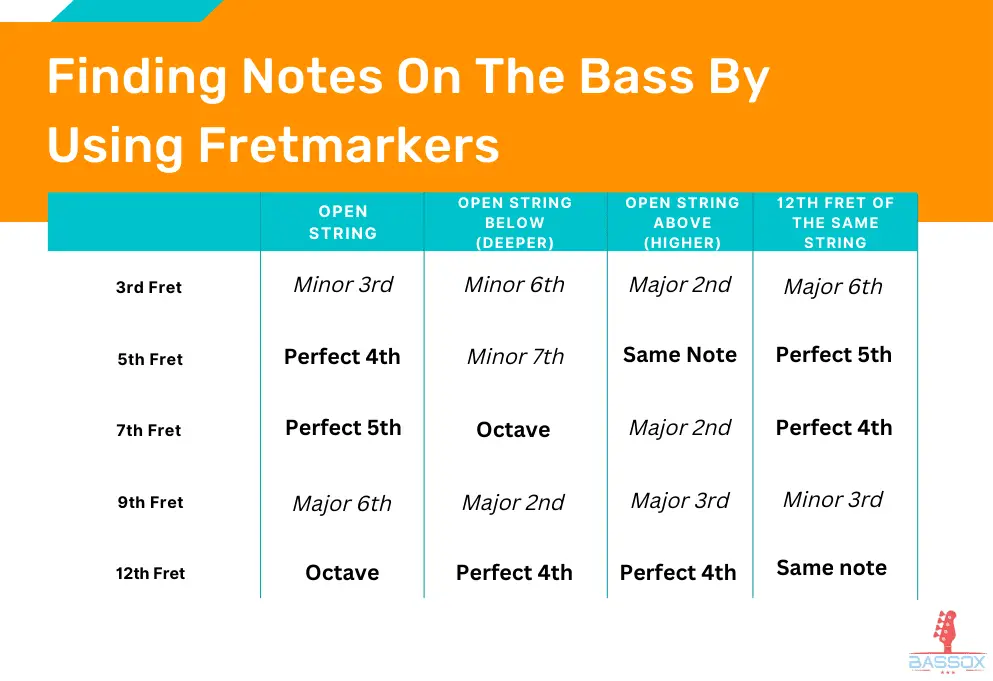
Using scales
When learning bass guitar notes, scales can be an immensely helpful tool. This is because scales always follow a set pattern. In turn, this means you don`t have to think about what notes the scale is made up off.
The two most important scales to learn are the minor and major scales. Here is what the minor scale looks like on the fretboard, and as tabs:
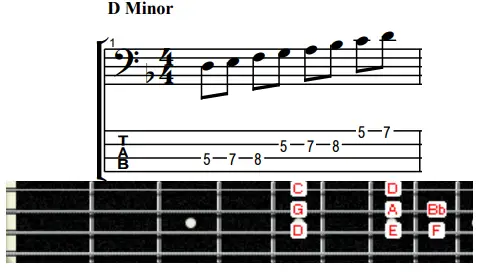
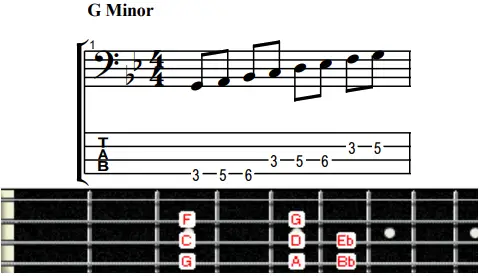
Notice how the D minor and G minor scales consist of the exact same pattern. The only difference is what note the scale starts on.
Thus, I highly recommend memorizing the pattern of this scale. When you have done that, you can use the fret markers to find every minor scale on the neck of the bass.
For example, let`s say you want to play a G# minor scale.
Off the top of your head, you don`t know where to find G#. However, by remembering what notes are found on the 5th fret, you know that the E-string played on the 5th fret is an A. You also know that G# is just a half-step below A. Thus, you can comfortably play the 4th fret of the E-string, knowing it is a G#.
You have also memorized the pattern of the minor scale. Thus, you can jump right into playing the G# minor scale from here. Pretty good, considering you didn`t even know where G# was on the neck of the bass.
The same holds true for the major scale. As most songs you will run into are written in either major or minor, learning these two scales is highly useful while learning the fretboard.
This is what the major scale looks like on the bass:
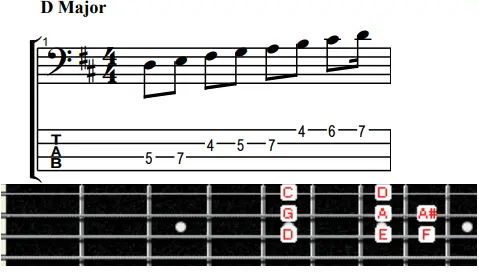
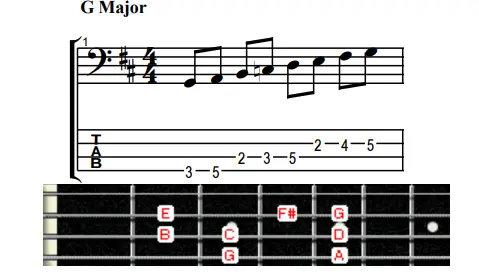
Alternate Tuning
It`s also worth noting that the notes on the neck of a bass guitar can be changed. This happens when the bass is tuned to an alternative tuning and the strings change pitch.
There are countless possible ways to tune a bass. However, the two most common ways to do so are by tuning to a different standard tuning or to a drop tuning.
The main tuning that basses use, and which we have talked about throughout this entire article, is E standard. For an example of a different standard tuning, here is a note chart of what D standard looks like:

The only difference between E and D standard is that the strings are tuned 1 whole step down.
Aside from that, everything else is the same. If you play a bassline written for E in D standard, it will have the same melody, but a deeper pitch. Alternatively, you could play the riff 2 frets up, and it would sound the same as in E.
Now let`s take a look at what the notes on a bass look like in Drop D tuning:

Drop D tuning is actually more similar to E standard than D standard. In fact, the only difference between E standard and Drop D is that the deepest string is “dropped” one whole step from E to D.
As a result, riffs written for E standard might not sound harmonious in drop D. This is because the interval between the two deepest strings is different than in standard tuning.
On the upside, you only have to tune and pay attention to one 1 more string than in E standard. The larger interval between the two deepest strings also enables you to play grooves that would otherwise have been difficult to play in standard tuning.
In general, alternate tunings are mainly used in rock and metal. Regardless of what genre you play though, it’s helpful to know that the notes on the bass guitar’s neck can sometimes change.
Bass Guitar Notes on a staff
Seeing the range of a bass guitar on staff is helpful if you know a bit of music theory. It is also helpful for getting a general overview of how far the range of the bass notes spans to better understand the role of the instrument.
First things first, this is what the range of a 21-fret 4-string bass guitar looks like when written out for the bass clef. The bass can play any note between the low E1 and the high E4.
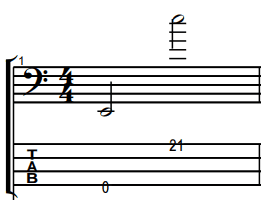
However, as I explained in my guide on middle C on the bass guitar, the bass guitar is a transposing instrument. This means that the instrument sounds differently from how its notes are written out.
In general, this is done in order to make writing sheet music easier and prevents excessive use of ledger lines. Thus, the actual range of the bass guitar looks like this:
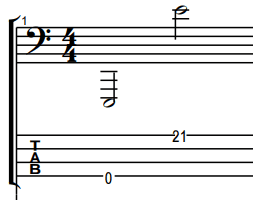
This is not something you have to concern yourself with most of the time. However, it is good to be aware that your instrument sounds 1 octave deeper than it is actually written out.
Lastly, here is a helpful chart of what the open strings, as well as the 5th, 7th, 12th, and 19th fret look like when tabbed and notated. This is approximately how much range most 4-string basses have, and is a good place to start for anyone taking a theoretical approach to learning the bass.

Conclusion
While it can be a lot to take in at first, learning all the notes on the bass guitar does not have to be as overwhelming as it is commonly made out to be.
To put it another way, after playing bass for 15 years, I still haven`t memorized what note is found on the 16th fret of the D string. However, give me one second to think and I`ll tell you it’s an F#.
This is because I know a couple of key reference notes I can navigate out from, and I know my scales. I also know that the 16th fret is the octave of the 4th fret, which makes it even quicker to find the right note.
With the help of the information in this article, you will be able to do the same with a little bit of practice. It won`t be effortless, but it will be a hundred times easier than trying to memorize every single note on the neck of the bass.

